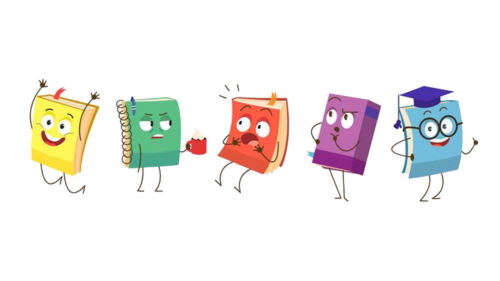📖 📕📗📘📙 📚
In the Objects section of the standard set of Unicode emoji available on devices with various operating systems, book icons occupy a rather significant place. Moreover, there are several of them. There are books with different cover colors, an open book, and a stack of colorful editions. Is there a difference in the meanings of these emoji, and in what cases which of the icons will be more appropriate to use? Let’s find out below.
📖 The Open Book emoji was assigned the code U+1F4D6, with which it was added to the Objects section of the Unicode 6.0 standard in 2010.
📕 The “Closed Book” emoticon was assigned the code U+1F4D5, with which it was added to the Unicode 6.0 standard objects section in 2010.
📗 The Green Book emoticon was assigned the code U+1F4D7, with which it was added to the Unicode 6.0 standard objects section in 2010.
📘 The “Blue Book” emoticon was assigned the code U+1F4D8, with which it was added to the Unicode 6.0 standard objects section in 2010.
📙 The Orange Book emoticon was assigned the code U+1F4D9, with which it was added to the Unicode 6.0 standard objects section in 2010.
📚 The “Books” emoticon was assigned the code U+1F4DA, with which it was added to the Unicode 6.0 standard objects section in 2010.
Meaning of the Book Emoji
A book is a symbol of the Universe, the universe of life. An open book means the so-called “book of life” – the teaching and spirit of wisdom. In the symbolism of the legends of the Grail, the book can also mean a quest and search. In Buddhism, the book symbolizes the perfection of wisdom, language and expression, in the Chinese it means scholarship. In Christianity, the book symbolizes the mission of the apostles to enlighten the nations.
The symbolism of the book is a self-evident symbol of wisdom, science and learning. The book is also widely used in iconography as a symbol of divine revelation, especially in Christianity and Islam. For Arab mystics, the book was a metaphor for life itself and all of creation.In some Grail legends, the knights are not looking for the Grail, but for the book and the lost word. In paintings, allegorical images of prophets, apostles (John the Evangelist is immersed in the Apocalypse), Christ, the Virgin Mary in the Annunciation scene, history, philosophy, and the Muses were depicted with books in their hands. A book with a cross signifies faith. The burning of a book symbolizes the abandonment of old beliefs and traditions.
The semantic load of the book symbol changed with the development of art and society. Until the 15th century, the image of the book embodied the Bible, the only literary source of the time. And, accordingly, symbolized divine wisdom. In the 15th century, for the first time in art, the book was given a broader meaning: henceforth it was no longer a symbol of divine wisdom, but of scholarship and cultural secularism. In the 17th century the book symbolizes its earthly existence, the right of science and education to be in the circle of revered things and the right to be respected by society.
The motif of the book, used by artists of the late 17th and 18th centuries, is most often an abstract-allegorical attribute of wisdom, knowledge, inspiration, which is intended to “ennoble” the painter’s craft and decorate his work. In the twentieth century, the classical image of the book recedes into the background. Such features of twentieth-century art as objectlessness, abstraction, contributed to the transformation of the classical image of the book into a sign, a symbol characterizing the continuity of cultures.
The Use of the Book Emoji
Books are a symbol of knowledge and education. Their use can indicate your interest in reading or that you are engaged in self-development and education. Usually, any of these emoji are used to indicate reading books or the process of learning. In addition, the Book emoji can be used in posts related to libraries or bookstores.
But also, the Open Book emoji and the Closed Book emoji carry allegorical meanings. Thus, an open book can mean sincerity and frankness (both of the person and the topic under discussion), while a closed book, on the contrary, can mean secrecy, reticence and unwillingness to discuss the issue at hand.
Conclusion
Book, education, reading are some of the most important things in everyone’s life. And book emoji are used by users from all over the world very often. They can signify a specific book or just the process of reading or studying. In addition, some of the proposed emoji can also be used in a figurative sense, indicating certain qualities of a person.














